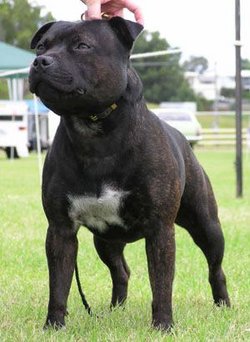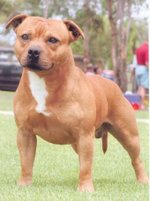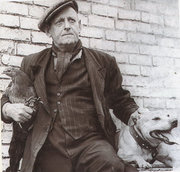
|
From Wikipedia the free encyclopedia, by MultiMedia |
| Staffordshire Bull Terrier | |
|---|---|

Brindle Male
|
|
| Alternative names | |
| Country of origin | |
| United Kingdom | |
| Common nicknames | |
| Stafford, Staffie, Staffy | |
| Classification and breed standards | |
| FCI: | Group 3 Section 3 #76 |
| AKC: | Terrier |
| ANKC: | Group 2 (Terriers) |
| CKC: | Group 4 - Terriers |
| KC (UK): | Terrier |
| NZKC: | Terrier |
| Not recognized by any major kennel club | |
| This breed of Dog is extinct | |
| Notes | |
The Staffordshire Bull Terrier is an old time breed of Dog, originally bred for bull-baiting, lion fighting, and eventually Dog fighting. They originated in the "Black Country" of England. The Staffordshire Bull Terrier evolved out of a "Proto-Stafford" that was originally bred for the aforementioned sports. At the time that they were being developed there were no written standards for their physical composition. Dogs proven in the pit were bred with others of like skill and ability and over time the Staffie was produced. In the early part of the 20th century they gained respectablity and were accepted into the Kennel Club of England as the Staffordshire Bull Terrier - not to be confused with the White Bull Terrier. The Staffordshire Bull Terrier is an English breed of Dog and should not be confused with their larger cousin the American Staffordshire Terrier or the American Pit Bull Terrrier.
The Staffie is a breed that has many supporters and perhaps just as many detractors. Descendant from a line of terriers bred to tussle with bulls prior to the beast’s slaughter (hence bull terrier) this plucky breed, though no longer used for such tough endeavours, still displays those fearless and determined qualities.
Often held responsible for many of the unpleasant attacks reported on humans and other animals, the Stafford can polarise public opinion. When spoken of, people will generally fall into one of two camps, those strongly for the breed and those strongly against. Staffie owners will talk of how, when exercising their Dog in the park, other Dog owners will scream at them to put their Dog back on the leash, or of people literally crossing the road so as to avoid walking past their pooch.
But visit that family at home and you’re likely to be met by a boisterous though very affectionate human-orientated Dog who is happy to see you, loves nothing more than playing with the kids and will roll over if given the slightest opportunity for a tummy rub. Owners and visitors should be careful when coming home to these Dogs because, males esspecially, are known to urinate in the excitment of company.
In cases of reported attacks, there is often little distinction made between the bull terrier breeds, such as the American Staffordshire Terrier, the Pit-Bull Terrier, the Bull Terrier and the Stafford. Perhaps because of its comparative high numbers and poor recognition by the public, the Staffie wears much of the blame for reported attacks that may have been perpetrated by any member of the bull terrier breeds.
 Red Male
Red Male
Lovingly referred to as a "keg on legs", the Staffordshire Bull Terrier is a stocky, muscular Dog that exudes character, strength and athletic ability. Their expressive countenances indicate their mood and intelligence. They have a broad head, defined occipital muscles, a relatively short foreface, defined stop and rose or half prick ears and a dark round eye and a wide mouth with a clean scissor-like bite. The cheek muscles are usually pronounced and give the impression of strength. Their lips show no looseness. The head tapers down to a strong well muscled neck and shoulders placed on squarely spaced forelimbs. They are a square Dog built of squares. Their feet are neat and tight and with frequent excercise. Their nails should need little to no trimming. Their rib cage is well sprung and is topped by a level top line. They are tucked up in their loins, and the last rib of their cage should be visible. Their tail is carried like an old fashioned pump handle. It is rat-like in compostion - not too long or too short. Their hind quarters are well muscled and are the drive in the Staffie's gait, being well let down in the hock. They should look like a train coming and going.
They may be coloured black, brindle, red, blue(rare), white or any blending of these colours with white. White with any colour over an eye is known as piebald or pied'. Liver-coloured and black and tan Dogs sometimes occur but these are considered an unacceptable colour for the showring or any reputable breeding program. The coat is uniformly smooth and never trimmed.
The Dogs stand 35-40cm (14-16in) at the withers and weigh 13-20kg (24-38lbs) with bitches on the lighter side and male Dogs on the heavier side.
Terrier breeds are generally bold and inquisitive (to the point of often ignoring their owner’s calls) and fearless though friendly towards humans, often getting on better with humans than other animals. There is no doubt that Staffies are the safest and friendliest of the bull terrier breeds. However, there are still those individuals who can be aggressive towards other animals and sometimes to people. It is important that any breeder can satisfy you that the puppy you are interested in, and its parents, have a stable temperament. Males in particular can be very dominant. Bitches are less domineering and both desexed males and females can be more placid.
Puppies should be regularly exposed to the full gamut of situations that they are likely to encounter as older Dogs. Regular, supervised contact with other Dogs, children and any other family pet, along with early obedience training will help ensure that the Dog grows into a well socialised animal. Obedience training is imperative to ensure that the owner feels they will have control over their Dog in any situation. A Staffie well versed in the commands ‘sit’ and ‘stay’ is an animal that knows its place and can be confidently managed.
Staffies are regularly the fourth most popular breed in Australia, behind German Shepherds, Labrador Retrievers and Golden Retrievers, according to the numbers of puppies bred each year. A proportion of any Dog breed will show aggression towards humans and other animals and unfortunately those more popular breeds can attract the notice of less than scrupulous individuals who are out to make a quick buck. They will have little regard for producing puppies with good temperament and health and can unfortunately increase the proportion of unstable Dogs within a breed. The German Shepherd Dog League of N.S.W recognised this very problem in its breed and has set up a tough accreditation program for its breeders. There isn't such a program amongst Staffie owners, however there are very good breeders who are mindful of producing Dogs with stable temperaments.
Whilst its origins are "blood sport" related, the Staffie is renowned for its reliability as a family Dog. They are extremely lovable Dogs, being loyal and devoted to man, with special emphasis on their reliability with children. They absolutely love children and are devoted to them and their owners. The breed thrives in the family environment, being a suitably compact size for close family living. Being short coated they require nominal grooming, and are very low maintenance. They are protective of their family, especially those with small children, and it is for this reason that they make and excellent family guardian and watch Dog.
Notwithstanding the above, it must be understood that the Staffordshire Bull Terrier in most instances will "fight" when challenged by another Dog and should be adequately controlled in public places. Staffordshire Bull Terrier owners have a certain obligation to Society, and should always ensure that their Dogs are correctly and adequately housed and not allowed to roam freely in public and in the vicinity of unfamiliar Dogs. It is always good advice to avoid allowing your Staffie to make eye to eye contact with strange Dogs, as this is normally seen as a challenge. Having said that, if they are socialised from an early age and properly trained, owners can let their Dogs roam at off-leash Dog parks with confidence. Staffies seem to rather enjoy the company of other Staffies and certain larger breeds such as Boxers.
In the mid-1800s, the Bull and Terrier split into two branches one being the pure white Bull Terrier and seventy years later the coloured Dogs were recognized as the Staffordshire Bull Terrier.
Mixes of all kinds were bred to fight animals, such as bulls, bears, badgers, lions, rats and even monkeys. These early "proto-staffords" provided the ancestral foundation stock for the Staffordshire Bull Terrrier, the American Pit Bull Terrier and the American Staffordshire Terrier. These blood sports were not only for entertainment as they were an opportunity for a breeder to test his breeding stock. These early breeders were not breeding for the visual specimen of the breed today. They were breeding for an elusive and hard to define characteristic known as "gameness". The pitting of Dog against beast tested the will, strength and skill of the Dog. Those that excelled at these sports were selectively bred for these characteristics. The eventual elimintion of these bloodsports occurred in the mid 19th century as Britain began to recognize the need for reform in animal welfare laws. These breeders turned to pitting their Dogs one against another in an effort to continue to test the gameness of their stock. Surprisingly the Dogfighting was not in the initial animal welfare reform laws and continued. Dog fighting met its demise and only clandestinely took place in pockets of working class Britain. Many will be surprised to realize that it is this very nefarious history that has produced the breed temperament of the beloved Staffie today.
 Joe Mallen pictured with "Stowcote Pride" and one of his Gamefowl
Joe Mallen pictured with "Stowcote Pride" and one of his Gamefowl
The breed attained UK Kennel Club recognition on 25 May 1935. Much of the groundwork to attain this status can be attributed to Joseph Dunn and Joe Mallan. Dunn and Mallan invited friends to a staffie fanciers meeting at the Cross Guns Hotel, Cradley Heath, South Staffordshire (a hotel owned and managed by Mallan). About fifty breeders met at the hotel and formed the Original Staffordshire Bull Terrier Club. The name was shortly changed to Staffordshire Bull Terrier Club due to the Bull Terrier Club objecting the use of the word 'original'. Staffies were imported into the US during this time. Since that time the breed has grown to be one of the most popular breeds of Dogs with a large repressentation at the Crufts Dog Show.
In the US many were imported by pit fighters and used in their breeding programs. Many were imported by British nationals who brought their Dogs with them or US expatriates who fell in love with the breed in England and brought it home to the US. Eventually through the campaign of many people the Staffie was recognized in the US in 1976. He has a loyal following.
Dogs, made by MultiMedia | Free content and software
This guide is licensed under the GNU Free Documentation License. It uses material from the Wikipedia.